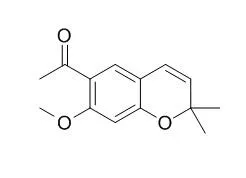| In vitro: |
| J Chem Ecol. 1989 Jul;15(7):2073-87. | | Eupatoriochromene and encecalin, plant growth regulators from yellow starthistle (Centaurea solstitialis L.).[Pubmed: 24272297] |
METHODS AND RESULTS:
Two chromenes, eupatoriochromene (1) and Encecalin (2), have been isolated from yellow starthistle (Centaurea solstitialis L.). Both chromenes retard seed germination and reduce radicle and hypocotyl growth of weed and crop plant seedlings. In addition,1 increases adventitious root formation of mung bean cuttings. | | J Chem Ecol. 1996 Mar;22(3):491-8. | | Fate of the chromene encecalin in the interaction ofEncelia farinosa and its specialized herbivoreTrirhabda geminata.[Pubmed: 24227488] |
METHODS AND RESULTS:
Leaf beetles of the speciesTrirhabda geminata are specialized herbivores that are able to feed on the chemically well-protected foliage of the desert sunflowerEncelia farinosa, which contains the insecticidal chromene derivative Encecalin. Chemical analysis of the beetles and their fecal excretions indicated that Encecalin is present only in the alimentary canal and is not absorbed across the gut membrane, as previously shown for other herbivorous insects (e.g., the Egyptian armyworm,Spodoptera littoralis) that are susceptible to this chromene derivative. Further differences betweenT. geminata and nonadapted insects were observed with regard to the metabolism of Encecalin. Whereas the Encecalin-resistent leaf beetles metabolize Encecalin mainly to encecalol by reduction of the acetyl group, susceptible insects, such as larvae ofS. littoralis, metabolize Encecalin mainly by exoxidation of the 3,4 double bond, which creates a powerful alkylating agent and is responsible for the toxicity of Encecalin.
CONCLUSIONS:
Reductive rather than oxidative metabolism of Encecalin therefore seems important for the resistance ofT. geminata against the chemical defense of their host plantE. farinosa. | | Journal of the Science of Food & Agriculture, 1998,78(1):102-8. | | Effect of encecalin, euparin and demethylencecalin on thylakoid electron transport and photophosphorylation in isolated spinach chloroplasts.[Reference: WebLink] | The major phytotoxic compounds (Encecalin, euparin and demethylEncecalin) isolated from Helianthella quinquenervis (Hook) A Gray (Asteraceae) were evaluated on different photosynthetic activities in chloroplasts isolated from spinach leaves.
METHODS AND RESULTS:
ATP synthesis, proton uptake and electron flow (basal, phosphorylating and uncoupled) were inhibited by Encecalin and demethylEncecalin in a concentration dependent manner, therefore acting as Hill reaction inhibitors. Encecalin and demethylEncecalin did not affect photosystem I (electron transport from diaminodurene to methylviologen), but they inhibited photosystem II (from water to 2,5-dibromo-3-methyl-6-isopropyl-1,4 p-benzo-quinone). Since these compounds inhibited electron flow in the photosystem II partial reactions from water to silicomolybdate and from diphenylcarbazide to dichlorophenol-indophenol, the site of inhibition was located in the span from P 680 to QA of the electron transport chain. Euparin, inhibited ATP synthesis, proton uptake and basal and phosphorylating electron transports, but it has not effect on uncoupled electron flow from water to methylviologen. Mg2+-ATPase activity from bound membrane thylakoid chloroplasts was also inhibited by this compound.
CONCLUSIONS:
These results suggested that euparin inhibited phosphorylation in chloroplasts, acting as an energy-transfer inhibitor. |
|






 Cell. 2018 Jan 11;172(1-2):249-261.e12. doi: 10.1016/j.cell.2017.12.019.IF=36.216(2019)
Cell. 2018 Jan 11;172(1-2):249-261.e12. doi: 10.1016/j.cell.2017.12.019.IF=36.216(2019) Cell Metab. 2020 Mar 3;31(3):534-548.e5. doi: 10.1016/j.cmet.2020.01.002.IF=22.415(2019)
Cell Metab. 2020 Mar 3;31(3):534-548.e5. doi: 10.1016/j.cmet.2020.01.002.IF=22.415(2019) Mol Cell. 2017 Nov 16;68(4):673-685.e6. doi: 10.1016/j.molcel.2017.10.022.IF=14.548(2019)
Mol Cell. 2017 Nov 16;68(4):673-685.e6. doi: 10.1016/j.molcel.2017.10.022.IF=14.548(2019)